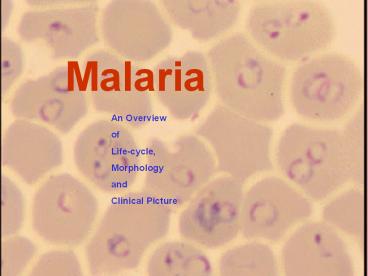Malaria - PowerPoint PPT Presentation
1 / 23
Title:
Malaria
Description:
Malaria An Overview of Life-cycle, Morphology and Clinical Picture Malaria Species Four species of malaria : Plasmodium falciparum: malignant tertian malaria ... – PowerPoint PPT presentation
Number of Views:626
Avg rating:3.0/5.0
Title: Malaria
1
Malaria
An Overview of Life-cycle, Morphology and
Clinical Picture
2
Malaria Species
- Four species of malaria
- Plasmodium falciparum malignant tertian malaria
- Plasmodium vivax benign tertian malaria
- Plasmodium ovale benign tertian malaria
- Plasmodium malariae quartan malaria
3
(No Transcript)
4
(No Transcript)
5
LIFE CYCLE OF MALARIA
sporozoites
Pre-erythrocytic (hepatic) cycle
Exo-erythrocytic (hepatic) cycle
6
Components of the Malaria Life Cycle
Sporogonic cycle
Infective Period
Mosquito bites uninfected person
Mosquito Vector
Parasites visible
Human Host
Mosquito bites gametocytemic person
Prepatent Period
Symptom onset
Recovery
Incubation Period
Clinical Illness
7
(No Transcript)
8
Plasmodium falciparum
Plasmodium vivax, Plasmodium ovale
Plasmodium malariae\
9
CLINICAL SIGNS SYMPTOMS OF MALARIA
Fever
Chills
Sweating
10
CLINICAL PICTURE
Chronic Disease
Acute Disease
Infection During Pregnancy
Chronic Asymptomatic Infection
Non-severe Acute Febrile disease
Placental Malaria
Cerebral Malaria
Anemia
Low Birth weight
Developmental Disorders Transfusions Death
Increased Infant Mortality
Death
11
Malarial Paroxysm
cold stage feeling of intense cold vigorous shivering lasts 15-60 minutes hot stage intense heat dry burning skin throbbing headache lasts 2-6 hours sweating stage profuse sweating declining temperature exhausted and weak ? sleep lasts 2-4 hours
12
Definition
- Severe malaria is defined as symptomatic malaria
in a patient with P. falciparum asexual
parasitaemia with one or more of the following
complications - Cerebral malaria (unrousable coma not
attributable to other causes). - Generalised convulsions (gt 2 episodes within 24
hours) - Severe normocytic anaemia (Htlt15 or Hb lt 5 g/dl)
- Hypoglycaemia (glood glucose lt 2.2 mmol/l or 40
mg/dl ) - Metabolic acidosis with respiratory distress
(arterial pH lt 7.35 or bicarbonate lt 15 mmol/l) - Fluid and electrolyte disturbances
- Acute renal failure (urine lt400 ml/24 h in
adults 12 ml/kg/24 h in children) - Acute pulmonary oedema and adult respiratory
distress syndrome - Abnormal bleeding
- Jaundice
- Haemoglobinuria
- Circulatory collapse, shock, septicaema (algid
malaria) - Hyperparasitaemia (gt10 in non-immune gt20 in
semi-immune)
13
Definition
- Uncomplicated malaria is defined as
- Symptomatic infection with malaria parasitemia
without signs of severity and/or evidence of
vital organ dysfunction.
14
Complications of malaria Cerebral malaria
15
Complications of malaria Pulmonary oedema
16
Complications of malaria anaemia
Child with severe malaria anaemia and no other
malaria complication
17
Child with severe malaria anaemia in conjunction
with acidosis and respiratory distress
18
Malarial haemoglobinuria
Clinical Picture Patients with
glucose-6-phosphate dehydrogenase (G6PD)
deficiency may develop intravascular haemolysis
and haemoglobinuria precipitated by primaquine
and other oxidant drugs, even in the absence of
malaria. Haemoglobinuria associated with malaria
(blackwater fever) is uncommon and malarial
haemoglobinuria usually presents in adults as
severe disease with anaemia and renal failure.
19
Common methods for parasitological diagnosis of
malaria
The two methods common in use 1 Light
microscopy 2 Rapid diagnostic tests (RDTs)
detecting circulating malaria antigens .
20
Microscopy is the gold standard for diagnosis of
malaria
- Parasite density
- Species diagnosis
- Monitoring response to treatment
21
Rapid diagnostic tests detect malaria antigens
Plastic cassette format of RDT
22
Rapid diagnostic tests detect malaria antigens
23
ACTION OF ANTIMALARIAL DRUG IN THE DIFFERENT LIFE
STAGES OF THE MALARIA PARASITE
- Sporontocides
- Primaquine
- Pyrimethamine
- Proguanil
- Tissue Schizontocides
- Primaquine
- Pyrimethamine
- Tetracycline
- Proguanil
Gametocyide Primaquine
- Anti-relapse (P.vivax)
- primaquine
Wellcome Trust (Modified)
- Blood Schizontocides
- Chloroquine
- Sulfadoxine/Pyrimethamine
- Quinine
- Quinidine
- Artemisinins































